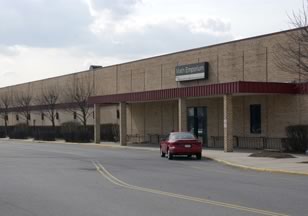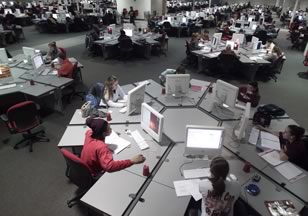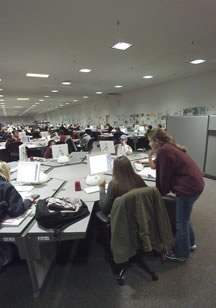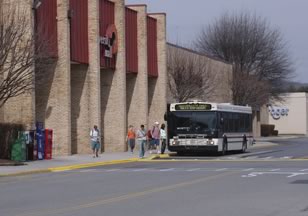Chapter 42. Virginia Tech: Math Emporium
Barbara L. Robinson and Anne H. Moore
What Is It?
Virginia Tech's Math Emporium is an open, 60,000-square-foot laboratory with 550 Macintosh computers serving more than 8,000 math students each semester. The facility occupies renovated, leased space in an off-campus shopping mall. (See Figure 1.) Spurred by the need to accommodate thousands of students and to improve learning outcomes, the emporium opened in 1997 to improve the quality of large-enrollment math courses in the face of growing resource constraints. Today, 11 courses have been redesigned to take advantage of the emporium, with demonstrable improvements in student learning and significantly reduced costs for staffing and space.
Figure 1. Street View of the Math Emporium

In addition to the open area where computers are arranged in six-station circular pods (see Figure 2), the Math Emporium has space for large orientation sessions, small conferences and tutoring, a math education lab, quiet study areas, and student lounges. The facility is open 24 x 7 and staffed days and evenings by math faculty, graduate students, and advanced undergraduate students who offer personal assistance when students request it. Peer group projects, collaboration, and tutoring are also encouraged. The combination of online courses and various sources of assistance offer students a wide variety of learning opportunities that they can tailor to meet their needs and preferences.
Figure 2. Open Area with Six-Station Computer Pods

Founded in 1872 as a land-grant institution, Virginia Polytechnic Institute and State University serves the Commonwealth of Virginia as one of its largest research universities. With the main campus located in Blacksburg, Virginia, Virginia Tech educates more than 27,000 students. It operates extension centers, experiment stations, and teaching and research centers across Virginia.
What Happens Here?
The Math Emporium supports a variety of activities:
- Active, independent learning through locally developed, self-paced online math courses designed to let students learn on their own schedules, while providing immediate feedback and sufficient structure to ensure students understand expectations and meet required milestones.
- One-on-one coaching by professors, graduate students, and advanced undergraduates who are available 15 hours a day to assist students having difficulty with material, in a comfortable, less-threatening environment than a faculty office.
- Proctored online exams, from which most of a student's grade for target math courses is derived.
- Group projects and help sessions, facilitated by comfortable, easily moved chairs and generous work space around each computer.
- Online video lectures for students who prefer that format.
- Independent study by anyone in the Virginia Tech community who wishes to take advantage of the high-end computers or the quiet study environment.
How Is Technology Used?
Technology is important at the Math Emporium primarily because it supports a unique Web-based teaching and testing system based on Mathematica templates, Java server pages, and Oracle databases. The system permits the use of streaming video, audio recordings, and other interactive tools to explain concepts. The focus, however, is on practice quizzes that cover all the skills a student is expected to learn in a course. These quizzes, generated on demand, offer a large number of random variations for each problem. This allows the 8,500 students registered in the system each semester, if they so desire, to practice until the program's immediate feedback indicates they have truly learned the particular skill.
Tests for credit are generated by the same system. Students who have mastered all the practice quizzes are assured they'll find no surprises in the tests. This emphasis on active performance rather than listening to lectures results in the delivery of 750,000 mathematics quizzes and tests each semester, with demonstrably improved understanding of material.1
What Makes the Space Successful?
Factors ranging from high-end hardware and software to a collaborative environment make the space successful.
High-end Mac OS X computers: Students are quick to complain when technology fails to meet their performance expectations. Computers and software in the facility are updated regularly, and lower support costs for Macs allows a single support person to maintain the equipment at high performance levels.
A friendly, nonthreatening, collaborative environment: While most students can learn the majority of the material independently, the math department staffs the emporium 15 hours a day with faculty, graduate students, and advanced undergraduate students who provide immediate one-on-one assistance. Thus, resources target specific times when personal interaction is most useful, as opposed to the less-efficient lecture model. The system also effectively removes faculty from the testing process, mitigating the potentially adversarial faculty/student relationship that might discourage positive interaction.
Local software development: Good software did not exist for courses to be taught at the emporium, requiring local development. Other systems were created to perform housekeeping chores such as assigning students to computers, tracking student performance, and even offering online, real-time information on emporium use so that students can determine if they will need to wait in line to use a computer.
Proctored testing: While learning occurs best when student-centered, there still exists a need for evaluation. No system yet developed efficiently and effectively performs accurate online evaluations without human supervision. While students can work on their math courses anywhere if they don't need personal assistance, they are required to take formal exams under supervision at the emporium.
Reducing the cost of a quality education: Courses converted to the emporium learning paradigm have reduced costs about 75 percent, primarily because the personal assistance offered at the emporium requires far fewer and lower ranked personnel than the traditional lecture format. Studies of student performance in courses downstream of emporium classes show students do as well or better than students from traditional math classes.
Flexible design: Carpeted flooring tiles raised 3 inches span the 60,000-square-foot learning laboratory for easy wiring deployment over time. The carpeting, in combination with special acoustical ceiling tiles, makes for a quiet study environment even when the emporium is filled to capacity. Long interior walls surrounding the emporium's open working spaces invite arts-and-crafts displays from the community (see Figure 3); scattered supporting columns display large-scale, locally designed, computer-generated graphics inspired by the space itself.
Figure 3. Wall-Mounted Community Art

Institutional support: No project this size can succeed without strong support at higher administrative levels as well as within sponsoring departments. Factors that smoothed the way for the creation of the Math Emporium included reduced budgets, a culture of innovation, and the desire to improve undergraduate teaching, particularly in the large introductory math courses that serve nearly all students at the university.
What Principles Were Behind the Design?
Space design reflects the openness and flexibility of the designs for learning in which math faculty are engaged; they can redesign learning spaces as learning needs change over time. In particular, emporium faculty employ the following tenets in their learning designs:
- Technology can be used to individualize a student's experience in a course, improving instruction. Allowing students to progress at their own pace, review material, and take practice quizzes as much as they like, while getting personal help only when desired, is a cost-effective way to improve the learning experience.
- Active learning, as opposed to the traditional lecture model, improves outcomes. Faculty and other coaches provide just-in-time assistance using techniques designed to allow the students to discover answers themselves.
- A course must clearly delineate expectations and provide comfortable and effective mechanisms to support learning. However, students gain other valuable real-world skills beyond course content, including self-discipline and organization, when entrusted with responsibility and authority to manage their own learning.
What Is Unique or Noteworthy?
The Math Emporium has improved math education at Virginia Tech while reducing costs by using an innovative learning paradigm with new expectations and motivations. The system is supported by locally developed software and made possible by the unique organization of space, complemented by high-end technology. Important features include:
- Taking advantage of the bottom-line orientation of many students ("What do I need to know to pass the test?")
- Replacing broadcast education with one-to-one coaching and programs that allow students to succeed at their own pace
- Tracking performance and providing immediate feedback
- Converting students from passive spectators to active participants in learning
Community Asset
The Math Emporium resides in a renovated off-campus space, making cost-effective use of the leased space. By designing numerous emporium-based learning activities, the math department freed many on-campus spaces for other uses. Furthermore, the renovation of a large, empty space (formerly a department store) anchoring one end of a shopping mall where a university bookstore was the anchor tenant at the opposite end helped revitalize a community asset that had been in decline for years. The community bus service, which many students use to get around town and campus, runs continuously and provides easy access to this off-campus site. (See Figure 4.) For those who prefer to drive, parking is readily available in lots surrounding the shopping mall. The mall's landlords are currently implementing plans to establish multifamily housing units and more small shops on the land occupied by the newly rejuvenated mall.
Figure 4. Math Emporium Bus

Endnote
- Michael Williams, "A Technology-Based Model for Learning," Journal on Systemics, Cybernetics, and Informatics, vol. 2, no. 6 (2005).
About the Authors
Barbara L. Robinson is the director of test scoring services for learning technologies at the Virginia Polytechnic Institute and State University.
Anne H. Moore is the associate vice president for learning technologies and director of information technology initiatives at the Virginia Polytechnic Institute and State University.